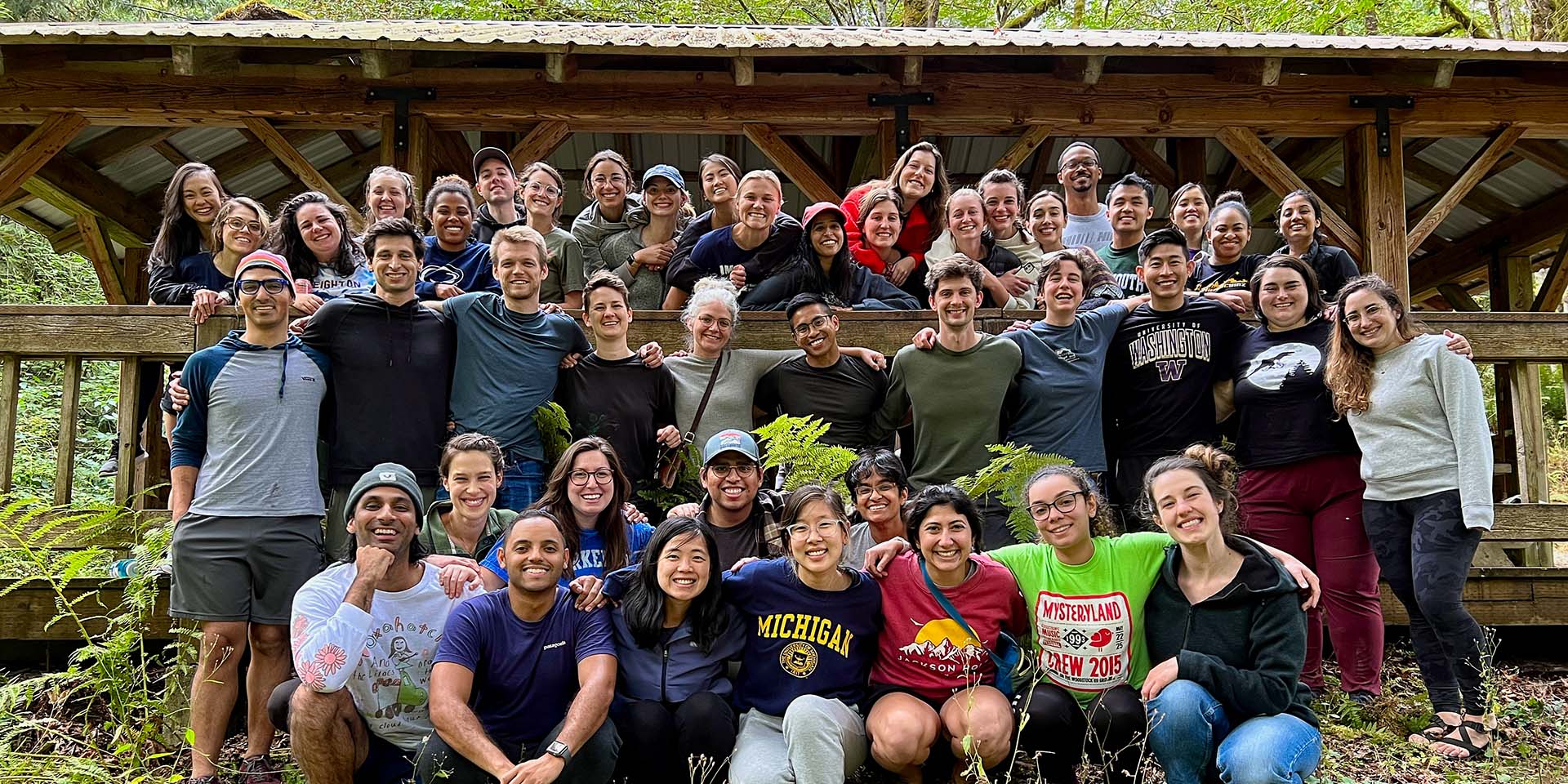
Program Overview
The goal of our program is to train well-rounded pediatricians who graduate feeling empowered to better the lives of children and their families. There are approximately 45 residents per class, comprised of 31 categorical residents and the remaining 14 in our specialized tracks or dual-specialty programs. Although we are one of the larger pediatric training programs, it doesn’t feel big. Residents in all tracks are firmly integrated within the categorical program and are a part of the larger family of the pediatric residency program.
We foster an inclusive and supportive environment where residents get to know each other well. Starting in the 2025-2026 Academic Year, our program will be transitioning to X+Y to both meet the new ACGME requirements and promote resident wellness and education.
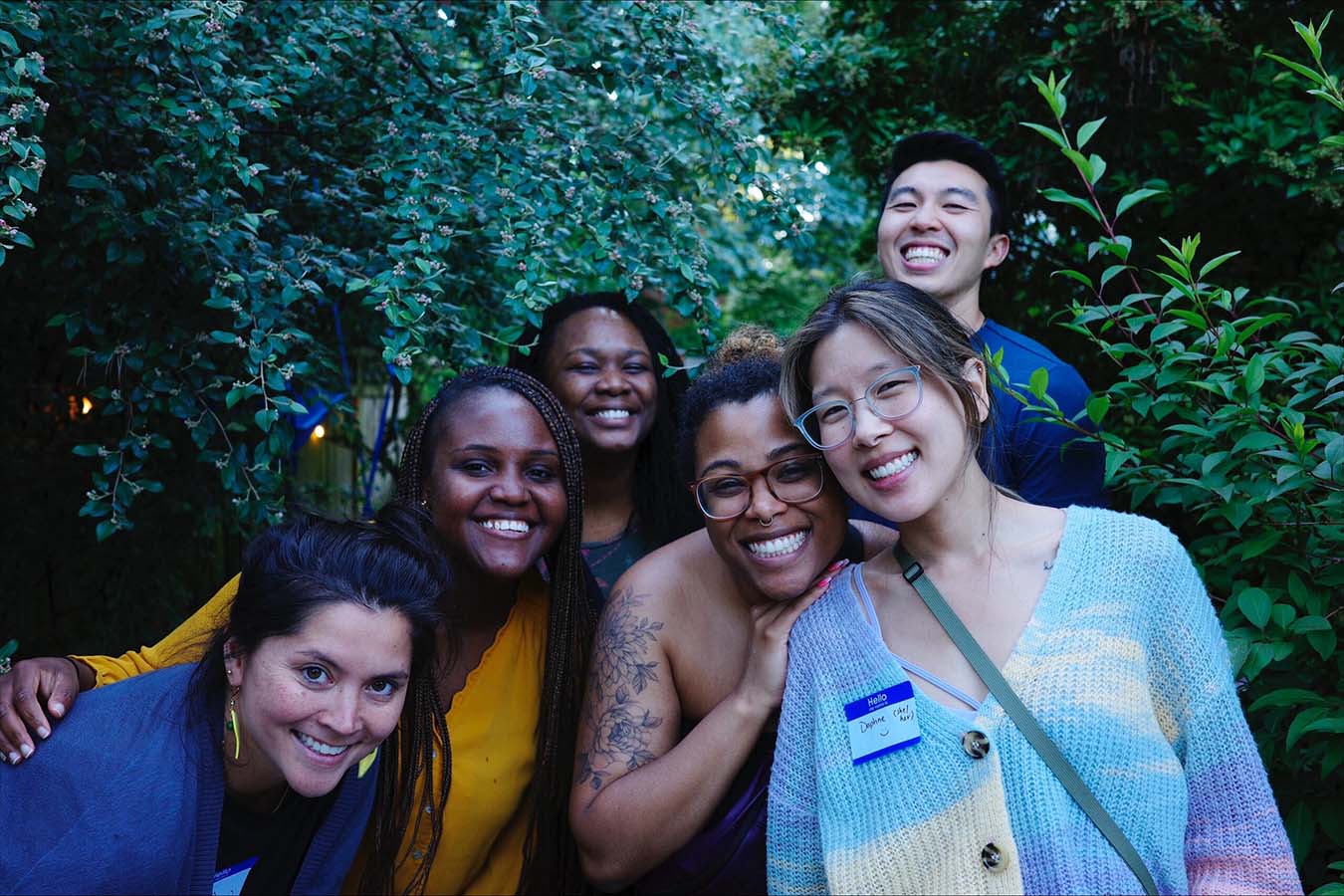
JEDI Initiatives
Systemic racism is a crisis that impacts our patients and community every day. As pediatricians, it is our responsibility to uphold the values of justice, inclusion, and equity.
Our pediatric residency at the University of Washington /Seattle Children’s Hospital is committed to fostering an environment of inclusion that values underrepresented minorities in medicine (URMs), including members of our community who identify as Black, Indigenous and People of Color (BIPOC) and lesbian, gay, bisexual, transgender, gender diverse, intersex, queer, asexual, questioning and allies (LGBTQIA+).
Affiliated Clinical Sites
From large academic centers to community clinics, our residents get trained in a variety of urban and rural clinical settings to serve the needs of children in our large and diverse catchment area.
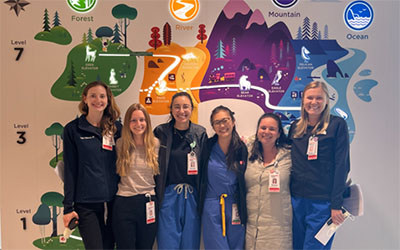 Seattle Children's Hospital is the only stand-alone children's hospital in the greater Seattle area. As the main clinical training site for pediatric residents, this 407-licensed-bed hospital is conveniently located 1.5 miles from the University of Washington campus. Seattle Children's serves as a community hospital for children in Seattle as well as the primary pediatric referral center for children throughout Washington, Wyoming, Alaska, Montana and Idaho (the WWAMI region).
Seattle Children's Hospital is the only stand-alone children's hospital in the greater Seattle area. As the main clinical training site for pediatric residents, this 407-licensed-bed hospital is conveniently located 1.5 miles from the University of Washington campus. Seattle Children's serves as a community hospital for children in Seattle as well as the primary pediatric referral center for children throughout Washington, Wyoming, Alaska, Montana and Idaho (the WWAMI region).
Pediatric residents rotating at Seattle Children's learn to care for children hospitalized with an exceptionally wide variety of childhood diseases, ranging from everyday pediatric illnesses to highly unusual conditions. See more facts and figures on Seattle Children's Hospital.
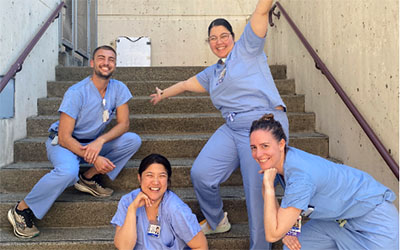 Located on the University of Washington campus, the University of Washington Medical Center is one of two primary teaching hospitals for the UW School of Medicine.
Located on the University of Washington campus, the University of Washington Medical Center is one of two primary teaching hospitals for the UW School of Medicine.
Pediatric residents rotate through the mother and baby unit and neonatal intensive care unit at University Hospital's Maternity and Infant Care Center. This center provides routine obstetrics and neonatal care, but also serves as the regional center for high-risk obstetrics and neonatal pediatrics.
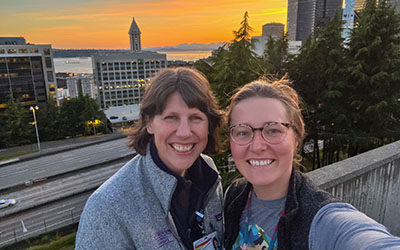 Founded in 1877, Harborview Medical Center is located in the heart of downtown Seattle and is one of two primary teaching hospitals for the University of Washington. Harborview is the only Level I trauma center in the entire five-state region, as well as a major referral center for burns, orthopedics and neurosurgery.
Founded in 1877, Harborview Medical Center is located in the heart of downtown Seattle and is one of two primary teaching hospitals for the University of Washington. Harborview is the only Level I trauma center in the entire five-state region, as well as a major referral center for burns, orthopedics and neurosurgery.
Pediatric residents rotate through Harborview for two to four months during their second and third years of training in the pediatric trauma, burn, and PICU units. Some residents also have weekly continuity clinic at this site, which is the medical home to a diverse urban population of children, including immigrants from many countries.
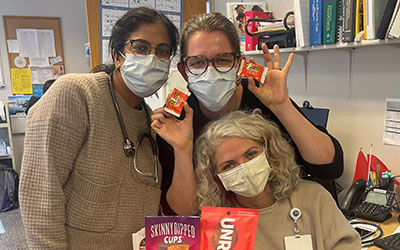 The continuity clinic experience offers residents the opportunity to provide longitudinal care to children throughout their three years of training. Our community clinics give residents the ability to cultivate relationships within the diverse communities of Seattle.
The continuity clinic experience offers residents the opportunity to provide longitudinal care to children throughout their three years of training. Our community clinics give residents the ability to cultivate relationships within the diverse communities of Seattle.
The clinic sites are as varied as our residents' interests, with each offering unique opportunities and perspectives. We believe you will find a continuity clinic site to nurture whatever your unique interests and goals may be as a pediatrician. Our continuity clinic schedule will change with the transition to X+Y starting the 2025-2026 academic year. More details to come!
University of Washington Medical Center – Roosevelt Pediatric Care Center (PCC)
- Neighborhood: University District, Seattle
- Residents per class: 12-13
- Clinic Facts: The Pediatric Care Center (PCC) at the University of Washington Medical Center (UWMC) – Roosevelt is the largest continuity clinic site. PCC serves as a medical home to patients from a varied socio-economic spectrum ranging from high-risk, low-income families to children of university graduate students, faculty and staff. About one-half of a resident’s panel is low-income families and about 15% of visits require an interpreter. Patients are commonly recruited from the newborn nursery at UWMC, giving residents a chance to develop a relationship with families starting at birth. Special clinic features include an Adoption Medicine clinic, behavioral health including a weekly Psychiatry clinic, and faculty expertise in fetal alcohol syndrome.
- Medical Director: Julia Bledsoe, MD
Harborview Medical Center Pediatric Clinic (HMC)
- Neighborhood: First Hill, Seattle
- Residents per class: 4
- Clinic Facts: Patients at HMC Pediatric Clinic come from among the most vulnerable populations in Seattle including low-income, immigrant/refugee, non-English speaking and families facing homelessness. Over half of the visits are interpreted using either telephonic or in-person interpreting. The largest ethnic groups represented are Somali, Hispanic, Ethiopian (Amharic/Oromo), Vietnamese and Cambodian. In addition to allowing cross-cultural healthcare encounters, the population served also has higher medical needs such as anemia, asthma, failure to thrive and developmental delay. Given the diversity of patients, this clinic is very well-suited for those interested in global health as part of their careers. Special features of the clinic include offering a Foster Care clinic and a Traumatic Brain Injury clinic.
- Medical Director: Anisa Ibrahim, MD
UW Neighborhood Kent/Des Moines Clinic (KDM)
- Neighborhood: South King County
- Residents per class: 9
- Clinic Facts: UW KDM is located in one of the fastest growing and most diverse areas of our region in south King County. Residents care for an underserved patient population with socioeconomic and cultural diversity, as well as a significant number of medically complex patients who receive specialty care at Seattle Children's. The residents and preceptors benefit from a level 3 medical home model, with a team-based, modern approach to primary care. KDM pediatricians work with a social worker, health navigator, nutritionist and on-site laboratory and radiology services. Special features include an active behavioral health program, which includes pediatric psychiatrists and cognitive behavioral therapy on site. The clinic also has family medicine providers, providing access to unique opportunities such as assisting on procedures, including IUD/Nexplanon placement and circumcision.
- Continuity Clinic Director: Nicole Johnson, MD
Neighborcare – Columbia City
- Neighborhood: Columbia City, South Seattle
- Residents per class: 4
- Clinic Facts: The continuity clinic at Neighborcare – Columbia City has provided primary care to families in the Columbia City area of Seattle for over 30 years. This clinic opened as a public health clinic in response to health care needs of vulnerable families including many immigrants and refugees. Neighborcare, a successful Federal Qualified Health Care (FQHC) community clinic network, assumed leadership of the clinic in 2014. The children seen at Columbia are diverse, low-income, mostly East African, Southeast Asian or Hispanic immigrant families and include medically and socially complex patients. The practice has many advantages of on-site services: social work, interpreter services, pediatric RN case management, nutritionists and integrated behavioral health services. In addition, special features include public health services on site including public health nursing, WIC and a dental clinic.
- Continuity Clinic Director: Heather Henne, MD
Odessa Brown Children’s Clinic (OBCC)
- Neighborhood: Rainier Valley, Seattle
- Residents per class: 3-4
- Clinic Facts: Odessa Brown Children’s Clinic (OBCC) is a community clinic of Seattle Children’s Hospital providing medical, dental and child behavioral health services to children and adolescents. Special features include an Asthma Clinic, ADHD Clinic, Fit4You (an obesity prevention and management program) and a Sickle Cell clinic, staffed by hematologists from Seattle Children's, held on site the second and fourth Thursday of every month. OBCC also runs the Teen Health Center at Garfield High School as well as medical services at First Place School, an elementary school for homeless youth and Wellspring, a daycare for low income and homeless families in the neighborhood.
- Continuity Clinic Director: Shaquita Bell, MD
Sea Mar Community Health Centers
- Neighborhood: South Park, Seattle
- Residents per class: 2
- Clinic Facts: Sea Mar is a busy community-based clinic serving low-income Spanish-speaking families living in the south end of Seattle and King County. About 90% of patient visits are conducted in Spanish and Spanish proficiency is a requisite skill for continuity clinic residents. Pediatric patients and their families benefit from Sea Marʼs behavioral health department, Head Start program, WIC program, maternity support services, dental clinic, pharmacy and child development center. Sea Mar has onsite lab and radiology. In-clinic professionals include a social worker, health educator, patient navigator and chronic care coordinators. This is a true community health center and pediatric residents work alongside family practice physicians and residents as well as OB/GYNs. All medical assistants and support staff are bilingual/bicultural.
- Continuity Clinic Preceptor: Cor Van Niel, MD
Eastgate Public Health Center
- Neighborhood: Bellevue
- Residents per class: 1
- Clinic Facts: The Eastgate Public Health Center is the only designated public health clinic available for resident continuity clinic. The clinic is housed within a full spectrum facility offering primary care, a teen clinic, nutrition, WIC, dental, maternal support services, environmental health services, family planning and STD services. The center is part of the King County Health Centers Network and primarily serves the low-income population in Bellevue and surrounding the East King County communities of Issaquah, Woodinville, Kirkland, Renton and Kent. The clinic sees a diverse range of Medicaid patients, and there is a sizable group of children with special health care needs. A majority of the families are Spanish-speaking immigrants. This site is a great site for residents interested in immigrant health and fluency in Spanish is a prerequisite.
- Continuity Clinic Preceptor: Crystal Shen, MD, MPH

Commonly referred to as the “WWAMI experience,” rural community training sites in Washington, Wyoming, Alaska, Montana and Idaho have been a unique part of medical education at the University of Washington School of Medicine since 1971.
As R2s, residents spend two months at one of six WWAMI practice sites, learning from community pediatricians about primary care in a rural setting. These practices are in Port Angeles, Yakima and Bellingham, Washington; Billings, Montana; and Pocatello, Idaho.
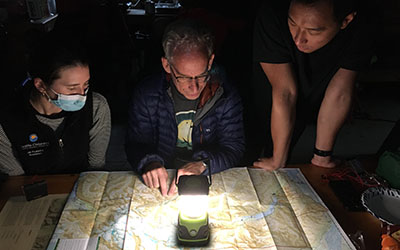 Because of the impressive size of the WWAMI region, primary care pediatricians are widely dispersed, often in sparsely populated areas that do not have easy access to subspecialty pediatric consultative services. In addition to their primary care responsibilities, these physicians must frequently provide emergency stabilization and hospitalization of sick children and facilitate occasional transport of children to tertiary centers such as Seattle Children's Hospital.
Because of the impressive size of the WWAMI region, primary care pediatricians are widely dispersed, often in sparsely populated areas that do not have easy access to subspecialty pediatric consultative services. In addition to their primary care responsibilities, these physicians must frequently provide emergency stabilization and hospitalization of sick children and facilitate occasional transport of children to tertiary centers such as Seattle Children's Hospital.
As an integrated member of a rural clinic, residents have an opportunity to work with these experienced physicians in managing simple to medically complex pediatric patients. Residents may also work with community pediatric hospitalists in local hospitals.
Learn more about the WWAMI experience.
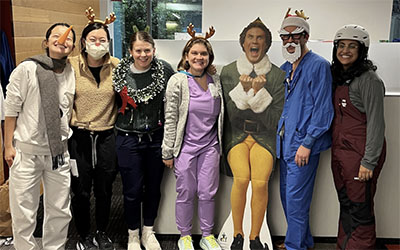 Pediatric fellows in multiple subspecialties are an important part of our educational model, providing excellent teaching opportunities without compromising resident autonomy. We also work with residents in family medicine, psychiatry, and anesthesiology who are doing pediatric-specific rotations in the wards, ED, and PICU. Additionally, Advanced Practice Provider (APP) Fellows are an integral part of our resident-led wards teams. These interdisciplinary trainees bring a diverse and well-rounded perspective to patient care and make the learning environment dynamic and team oriented.
Pediatric fellows in multiple subspecialties are an important part of our educational model, providing excellent teaching opportunities without compromising resident autonomy. We also work with residents in family medicine, psychiatry, and anesthesiology who are doing pediatric-specific rotations in the wards, ED, and PICU. Additionally, Advanced Practice Provider (APP) Fellows are an integral part of our resident-led wards teams. These interdisciplinary trainees bring a diverse and well-rounded perspective to patient care and make the learning environment dynamic and team oriented.
We also work alongside and learn from diverse interdisciplinary colleagues daily; this includes but is not limited to nurses, respiratory therapists, child life specialists, pharmacists, dietitians, physical therapists, and speech language pathologists. One of the most unique teams at Seattle Children’s is the Cultural Navigator team, which helps patients and their families overcome language, health literacy, financial, and cultural barriers to advocate and improve healthcare delivery and outcomes.
Community Outreach and Advocacy
At UW/Seattle Children’s, we believe that advocating for children’s health is one of the foundational cornerstones to building a productive pediatric career. In addition to the resident-led Advocacy Council, residents and faculty are involved in many different projects that promote child health at the community, state, and national level.
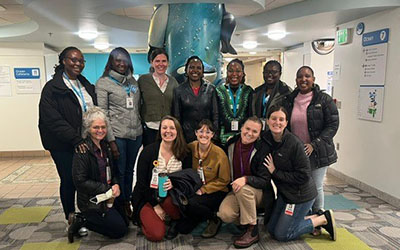 Categorical residents interested in structured community advocacy and integrating public health into their training are encouraged to apply to the REACH Pathway.
Categorical residents interested in structured community advocacy and integrating public health into their training are encouraged to apply to the REACH Pathway.
These residents develop meaningful relationships with providers and communities in Toppenish, Washington or Kisii, Kenya.
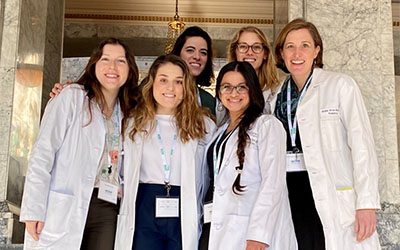 The American Academy of Pediatrics (AAP) is the main advocacy organization for pediatricians in the country. Four representatives from every class (three from categorical and one from the Alaska Track) are chosen by their peers each year to participate in local, regional and national AAP advocacy work. Second-year representatives are involved in organizing a resident advocacy campaign as selected by the Section on Medical Students, Residents and Fellowship Trainees at each year’s AAP National Conference.
The American Academy of Pediatrics (AAP) is the main advocacy organization for pediatricians in the country. Four representatives from every class (three from categorical and one from the Alaska Track) are chosen by their peers each year to participate in local, regional and national AAP advocacy work. Second-year representatives are involved in organizing a resident advocacy campaign as selected by the Section on Medical Students, Residents and Fellowship Trainees at each year’s AAP National Conference.
Throughout residency, representatives serve as experts on Washington state legislative issues and lead advocacy efforts within our residency program. Efforts culminate during an Advocacy Day in February where residents partner with faculty AAP members and speak to state legislators directly.
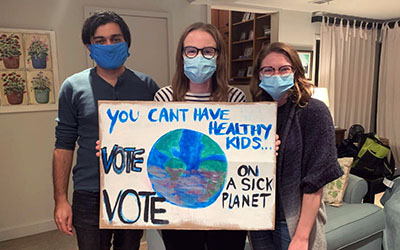 Pediatricians for Climate Action is a group started by our residents and dedicated to raising awareness of the impacts of climate change on children’s health. Our work includes research, education, and legislative advocacy.
Pediatricians for Climate Action is a group started by our residents and dedicated to raising awareness of the impacts of climate change on children’s health. Our work includes research, education, and legislative advocacy.
Current projects include:
- ED visits and hospitalizations during wildfires
- Building a climate change and children’s health curriculum at Seattle Children’s
- A national survey project to determine trainee knowledge of climate change and health
- Working with the WA AAP and other groups to promote climate legislation at the state level
 Each August, Stanley Stamm Summer Camp gives children with serious illnesses the chance to go fishing, ride horses and take part in other activities typical of summer camp at a week-long sleepover camp near Mt. Rainier.
Each August, Stanley Stamm Summer Camp gives children with serious illnesses the chance to go fishing, ride horses and take part in other activities typical of summer camp at a week-long sleepover camp near Mt. Rainier.
Our camp, founded by Seattle Children’s first pediatric cardiologist, Dr. Stanley Stamm, includes medical support so that children who are unable to attend other camps can join in the fun.
Residents are invited and encouraged to attend as camp counselors and volunteers, and many return year after year.
